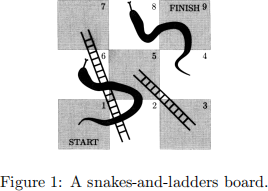Math 447 – Winter 2023 Assignment 1
Hello, dear friend, you can consult us at any time if you have any questions, add WeChat: daixieit
Math 447 – Winter 2023
Assignment 1
Due January 18, 2023
Some of these problems are adapted from Dobrow. For those problems, the numbers refer to the problem numbers in the book.
1. (1.22) Find E(Y |X) when (X,Y) is uniformly distributed on each of the following regions.
(a) The rectangle [a,b] ⇥ [c,d].
(b) The triangle with vertices (0, 0), (1, 0), (1, 1).
(c) The disc with radius 1 centered at the origin.
2. This question concerns Markov chain modelling of the game of snakes and ladders. For the purposes of this assignment, the rules of snakes and ladders are as described on the last page of the assignment.
Consider the snakes-and-ladders board in Figure 1.

(a) Imagine a single player playing snakes-and-ladders on this board using a six-sided die. Give a transition matrix for a Markov chain with 5 states that models this.
(b) For the same game as in question (a), give a transition matrix
for a 9-state Markov chain, with states 1, . . . , 9 representing the 9 squares of the board, for which it is possible to compute, e.g.,
P(T{3} < T{5}), and more generally any probability of the form
P(TA < TB|X0 = 1).
Here TA = min(k : Xk 2 A) is the first hitting time of set A and A,B can be any subsets of {1, . . . , 9}.
(c) Describe the state space and transition probabilities for a Markov chain modelling n-player snakes-and-ladders played on the board in Figure 1. Here n can be any positive integer.
3. Recall the notation [n] = {1, . . . ,n} from class. Describe a Markov chain whose state space is the set of all subsets of [n], which models the evolution of the set of sampled integers when uniformly sampling without replacement from [n].
4. (2.2) Let X0,X1 , . . . be a Markov chain on {1, 2, 3} with transition
matrix

and initial distribution ↵ = (![]() , 0,
, 0, ![]() ). Find the following:
). Find the following:
(a) P(X2 = 1 | X1 = 3)
(b) P(X1 = 3,X2 = 1)
(c) P(X1 = 3 | X2 = 1)
(d) P(X9 = 1 | X1 = 3,X7 = 2)
5. (Extension of 2.19) Let P be the transition matrix of a Markov chain with state space [k], and let I denote the k ⇥ k identity matrix. Fix p 2 (0, 1) and let Q = pI + (1 − p)P. Show that Q is a stochastic matrix, and give a probabilistic interpretation of the dynamics of a Markov chain with transition matrix Q, in terms of the dynamics of P.
6. Show that the Markov chain with the transition graph shown in Fig- ure 2 can not be represented as a random walk on an undirected weighted graph.
(Recall that an undirected weighted graph is a graph G = (V,E) with undirected edges, together with non-negative edge weights (w(e),e 2 E).)

Figure 2: The transition graph of a Markov chain with state space {1, 2, 3, 4}.
Snakes and ladders rules
(a) Each player begins with a token or figure on the ‘1’ square in the
bottom left-hand corner of the board. Players take turns rolling a six-sided die and moving their token in accordance with the number they roll. If they roll a one they move one square; if they roll a two they move two squares, and so on.
(b) If a player lands on the lower end of a ladder, they ‘climb’ that ladder to the square that features its top end.
(c) Conversely, if players land on the higher-numbered square of a snake, they fall down to its lowest-numbered square.
(d) If a player rolls a number which is larger than the distance to the finish, they remain at their current square.
(e) Whoever reaches the last square (the finish) first is the winner.
2023-02-04